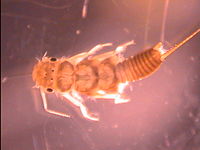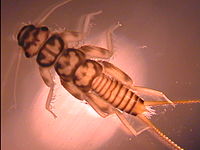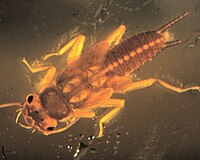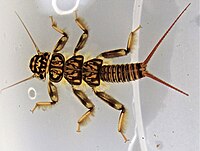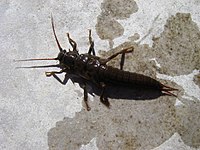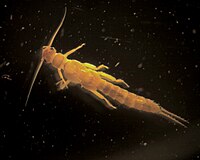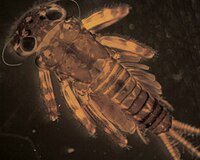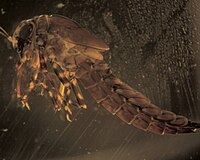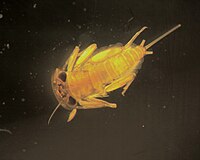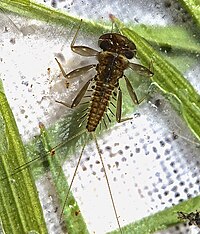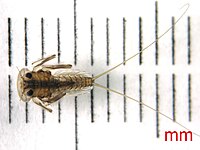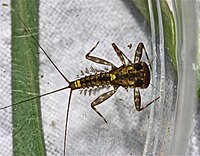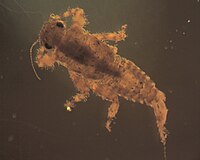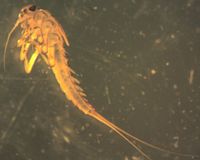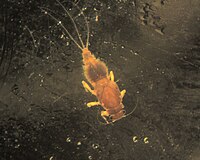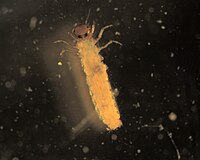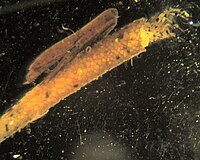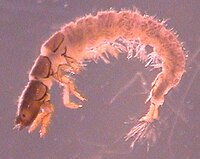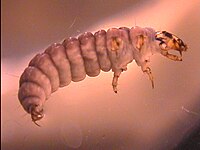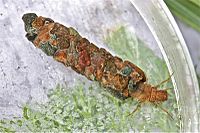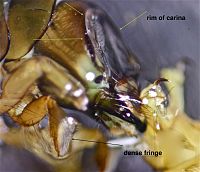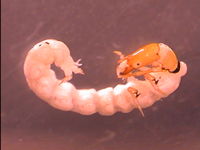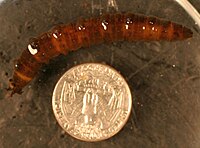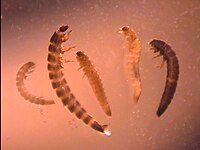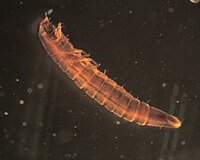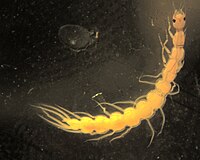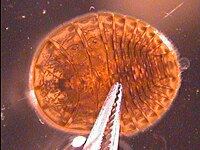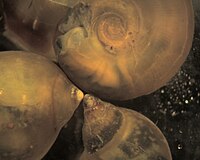Vermont EPSCoR's Streams Project; A Teacher Collaboration on WikiEducator
Openly shared content, practices, and developing resources from Vermont EPSCoR's Streams Project. Join this collaboration and make a difference!
 MillRiverMass |
|---|
|
| Basin: | Connecticut River |
| State or Province: | Vermont |
| Country: | USA |
| Latitude: | 42.318110 |
| Longitude: | -72.642064 |
| School: | Smith College |
Really it is in Mass but the App does not currently support Mass.
Please leave the Vermont designation or the stream will not appear in the phone app
The following are the most common invertebrates collected from this stream site.
Acroneuria
- Order
- Plecoptera
- Family
- Perlidae
- Genus
- Acroneuria
Acroneuria are among the most common Perlid stoneflies that we find. The larvae have a close-set postocular fringe consisting of thick spinules. They have three ocelli, and a yellow m-shaped mark in front of the middle ocellus. The bases of their cerci have thick, silky setae.
The postocular fringe can be seen here. Look in front of the three ocelli for the yellow m-shaped mark. Focus where the cerci meet the body to see the thick, silky setae.
Perlidae
- Order
- Plecoptera
- Family
- Perlidae
- Common name
- The Golden Stonefly Creeper
- Tied fly
- Connecticut Curler
This stonefly is characterized by the three pairs of filamentous gills located on the sides of all three thoracic segments. It is distinguished from the family Pteronarcyidae by the absence of gills on the abdominal segments. Often, the thoracic terga are brightly patterned as pictured, though this is not always the case. Another important feature is that the paraglossae and glossae extend different lengths.
Images of filamentous gills and the family Pteronarcyidae.
Genera commonly encountered in this family include Acroneuria, Agnetina, and Paragnetina. Less commonly, we have found Perlesta.
Very rarely encountered genera include Neoperla and Hansonoperla. If you believe you have found either of these, please send a specimen our way!
Perlesta
- Order
- Plecoptera
- Family
- Perlidae
- Genus
- Perlesta
Perlesta are distinguished by an irregularly spaced row of spinules on their occiptal ridges. The cerci lack fringes of setae, and the abdominal terga have more than five intercalary bristles.
Images of the occipital ridges, cerci, and the abdominal terga.
Paragnetina
- Order
- Plecoptera
- Family
- Perlidae
- Genus
- Paragnetina
Paragnetina have 3 ocelli (spots) on the back of their head. Like the other Perlidae, there are highly branched gills located on the sides of the thorax. The dorsal sides of the abdominal segments have small hairs on lateral portions but not in the center of the segment.
Pteronarcys
- Order
- Plecoptera
- Family
- Pteronarcyidae
- Genus
- Pteronarcys
- Common name
- The Giant Stonefly
- Tied fly
- Kaufmann's Black Stone
Pteronarcyidae have branching gills from the bases of their legs as does
Perlidae. What distinguishes Pteronarcyidae from Perlidae is the presence of gills on the first two abdominal segments. There are only two genera in this family, but the other,
Pteronarcella, is only found in the west/southwest.
Click to see an example of Perlidae or the gills on the first two abdominal segments.
Chloroperlidae
- Order
- Plecoptera
- Family
- Chloroperlidae
- Common name
- The Yellow Sally
- Tied fly
- Yellow Sally
Stoneflies from the family Chloroperlidae have cylindrical banded abdomens. When observing their mouthparts, the glossae and paraglossae form a three-pronged (open) notch, and their hind wing pads are parallel (not divergent). Cerci have a vertical fringe of hairs pointing away from the abdomen. Setae on the pronotum are found primarily at the corners.
Maccaffertium
- Order
- Ephemeroptera
- Family
- Heptageniidae
- Genus
- Maccaffertium
- Common name
- The March Brown
- Tied fly
- March Brown
This genus of
Heptageniidae is distinguished by its gills on the seventh abdominal segment, which are reduced to slender filaments. Gills on segments 1-6 are truncated.
Images of the slender filaments, and the truncated gills.
Template:Stenonema
Isonychia
- Order
- Ephemeroptera
- Family
- Isonychiidae
- Genus
- Isonychia
- Common name
- The Dun Variant
- Tied fly
- Flick's Dun Variant
This mayfly has unique long hairs on its forelegs as the main distinguishing characteristic (allowing anyone keying to move through quickly). Carefully observe the limbs because such hair can be matted down and therefore hidden in preserved wet specimens. The body of
Isonychia is slim and "minnow-like" when observed dorsally. In specimens we collected, they were commonly brown and substantial in length and width as compared to the very common Baetidae.
Even when individuals are immature, closer inspection can reveal the setae on the forelegs.
Image of the long hair on its forelegs.
Rhithrogena
- Order
- Ephemeroptera
- Family
- Heptageniidae
- Genus
- Rhithrogena
- Tied fly
- Dark Blue Upright
This three-tailed genus of mayfly has whitish gills that appear fluffy; some species have bright red gills when alive. The gills on abdominal segments 1 and 7 are larger than the others and almost meet underneath the abdomen.
Click to view picture of the gills
Leucrocuta
- Order
- Ephemeroptera
- Family
- heptageniidae
- Genus
- Leucrocuta
- Common name
- Little Yellow Quill
- Tied fly
- Wingless Pale Evening Dun
This mayfly genus shares the distinctive flat head of all members of it's family. More descriptive characteristics of the genus will be added shortly
Heptageniidae
- Order
- Ephemeroptera
- Family
- Heptageniidae
- Common name
- flatheaded mayfly
- Tied fly
- Light Cahill, Wingless Pale Evening Dun
This family of mayflies can be characterized by their distinctly flattened heads and striking resemblance of the character 'Jack Skellington' from the movie 'The Nightmare Before Christmas.' This family can either have two or three cerci (tails).
Commonly encountered genera include:
Epeorus
Heptagenia
Maccaffertium
Rhithrogena
Heptagenia
- Order
- Ephemeroptera
- Family
- Heptageniidae
- Genus
- Heptagenia
- Tied fly
- Little Graywinged Olive
Heptagenia are easily characterized by their flat head. The claws have just one basal tooth and no denticles (serrated edges). The gill on abdominal segment 7 has multiple fibrils at is base (thread-like structures) and has a single tooth on its claws but is smooth otherwise. Gills on segment 7 are similar to those on all other segments, but may be smaller in size.
Template:Dannella
Serratella
- Order
- Ephemeroptera
- Family
- Ephemerellidae
- Genus
- Serratella
Serratella's distinguishing feature is the set of paired tubercles on the dorsum of its abdomen.
Click her to view the paired tubercles.
Baetidae
- Order
- Ephemeroptera
- Family
- Baetidae
- Common name
- Small minnow mayfly
- Tied fly
- Tiny blue-winged olive
This mayfly has either two or three cerci ("tails") and a unique head shape. Its gills are oval shaped and insert dorsally. Commonly encountered genera include
Acerpenna,
Baetis and
Pseudocloeon.
More information on the genera:
Acerpenna
Baetis
Pseudocloeon
Caenis
- Order
- Ephemeroptera
- Family
- Caenidae
- Genus
- Caenis
- Tied fly
- Tiny Graywinged
These mayflies are characterized by square-shaped operculate (plate-like) gills on the second abdominal segment.
Nigronia
- Order
- Megaloptera
- Family
- Corydalidae
- Genus
- Nigronia
Members of the genus
Nigronia share some superficial commonalities with Trichoptera, but on careful inspection one can see the two pair of anal claws that help place it in the order Megaloptera. The size of mature larvae is impressive; specimens from other genera exceed 8 cm in length. The abdominal segments have ribbon-like gills on the lateral portions. The mouth has mandibles that are serrated and used for biting prey. They can be confused with the more slender whirling beetle larvae; whirligig larvae also have simpler jaws.
Images of the two pairs of anal claws, whirligig beetle larvae and their simpler jaws.
Hydropsyche
- Order
- Trichoptera
- Family
- Hydropsychidae
- Genus
- Hydropsyche
- Common name
- spotted caddis
- Tied fly
- dark cahill
Hydropsyche are net-spinning caddisflies and share most characteristics with other members of the Hydropsychidae, including the
Ceratopsyche.
Hydropsyche are distinguished from
Ceratopsyche by the presence of scale hairs and minute spines on the three most posterior abdominal segments.
More information on the Ceratopsyche can be found here.
Image of the sclerites in the intersegmental folds.
Limnephilidae
- Order
- Trichoptera
- Family
- Limnephilidae
- Tied fly
- Paul Young's Strawman Nymph, Grouse and Orange
This family of Trichoptera is characterized by having sclerotization on the dorsal surface of the first two thoracic segments. Also, it has a dorsal hump on the first abdominal segment, along with two lateral humps. Here, on a more mature specimen, one can see the
prosternal horn characteristic of it and another family Uenoidae. More information on the
Uenoidae.
Images of the dorsal hump, the two lateral humps, and theprosternal horn.
Leptoceridae
- Order
- Trichoptera
- Family
- Leptoceridae
- Tied fly
- White Miller, LaFontaine Dancing Caddis
At least two genera from this family are common in Lake Champlain. The species in the genus Nectopsyche that we have found is very long (2.5 cm) and slender. Oecetis cases from our samples are shaped like cornucopia.
Template:Oecetis
Template:Lepidostoma
Cheumatopsyche
- Order
- Trichoptera
- Family
- Hydropsychidae
- Genus
- Cheumatopsyche
Cheumatopsyche has a
forked foretrochantin (as does
Ceratopsyche). The foretrochantin is the projection at the uppermost portion of the front leg closest to the head. The leg may need to be pulled away from the body to expose this feature.
Cheumatopsyche have a small or inconspicuous
pair of sclerites under the prosternal plate that are difficult to see. Contrast that with the
larger pair of sclerites found on Ceratopsyche. To access sclerites, it's best to gently pull the pronotum and mesonotum in opposite directions. Note: the large single sclerite is the prosternal plate.
Cheumatopsyche have only 2 types of
hair on the abdomen: long thin plain hairs and thicker club hairs, which are narrow close to the body and widen out at the distal end. Paired sclerites on the ninth abdominal segment are notched.
Rhyacophila
- Order
- Trichoptera
- Family
- Rhyacophilidae
- Genus
- Rhyacophila
- Common name
- Green Caddis
- Tied fly
- Henryville Special or Glass Bead Caddis
In our lab,
Rhyacophila is known as the "Michelin Man" due to its large banded body. It has a very obviously checker-patterned head. It also has terrifying anal claws with large accessory hooks.
Links to images that may be useful if you have a magnifying glass or microscope:
Checker-patterned head.
Anal claws with large accessory hooks.
Pycnopsyche
- Order
- Trichoptera
- Family
- Lymnophilidae
- Genus
- Pycnopsyche
- Common name
- Great Brown Autumn Sedge
- Tied fly
- Grouse and Orange
This genus includes the largest caddisflies that we collect. Case circumferences can be almost as large around as a small pencil. The photographed individual's case is made from sand but materials used can include leaves, sticks, and small gravel.
Macrostemum
- Order
- Trichoptera
- Family
- Hydropsychidae
- Genus
- Macrostemum
- Common name
- The Zebra Caddis
- Tied fly
- Emergent Sparkle Pupa
This net spinning caddisfly genus has similar overall morphology to other members of the Hydropsychidae. It can be distinguished from others in the family by the dinner plate-shaped depression on it's head that is rimmed by a ridge or carina. This feature is sufficiently prominent to be viewed using a hand lens.
Chimarra
- Order
- Trichoptera
- Family
- Philopotamidae
- Genus
- Chimarra
Chimarra are distinguished from the other Philopotamidae by a prominent asymmetrical notch in the frontoclypeus as well as a prominent process on the femur which bears a single hair (seta).
Images of the asymmetrical notch and prominent process.
Tipulidae
- Order
- Diptera
- Family
- Tipulidae
- Common name
- The Crane Fly
- Tied fly
- Gangle Legs
Like other larvae from the order Diptera, members of the family Tipulidae (crane flies) lack legs. Tipulidae have retracted, difficult-to-see head capsules at one end, and a spiracular disk at the other end. The spiracular disk can sometimes look like a face leading to some confusion about which end is which. Upon gently cutting the head open, one can see that the mandibles are not parallel to each other, but rather move against each other.
The genera we've encountered include Antocha, Dicranota, Hexatoma, Limnophila, Molophilus, Pedecia and Tipula.
Chironomidae
- Order
- Diptera
- Family
- Chironomidae
- Common name
- Nonbiting midge
- Tied fly
- Griffith's Gnat
Midge larvae tend to be the most common macroinvertebrate at our sites. As with other Diptera, there are no true jointed legs. Chironomidae do have a pair of prolegs at each end and preserved individuals tend to curl into a 'C'. Identification past family requires slide-mounted heads. We have seen philopotamid caddisflies misidentified with the chironomids and we suspect that that happens when samples are being sorted from trays. Under a microscope, six prominent legs can be seen on members of the caddisfly family Philopotamidae.
More information on Philopotamidae.
Elmidae
- Order
- Coleoptera
- Family
- Elmidae
- Common name
- riffle beetle
We very commonly find adult and larval riffle beetles. The adults are clearly beetles, but the larvae can be confused with other orders. The forward pointing tooth on the front end of the larvae as described in the key can be a challenge to see, particularly in small individuals. Larvae are characterized by having a single tarsal claw at the end of their legs, which have 4 segments. Adults, on the other hand, have two tarsal claws at the end of each leg. Commonly encountered genera include
Dubiraphia,
Macroychu,
Optioservus,
Phanocerus,
Promoresia, and
Stenelmis.
Images of the adult and larval riffle beetles.
More information on Dubiraphia, Macronychus, Optioservus, Phanocerus, Promoresia, and Stenelmis.
Template:Microcylloepus
Stenelmis
- Order
- Coleoptera
- Family
- Elmidae
- Genus
- Stenelmis
The larvae of
Stenelmis, as in
Ordobrevia, have a sternum on the ventral side of the pronotum. The main difference between the two genera is in the antennae the second segment is less than twice as long as the first in
Stenelmis.
The adult Stenelmis has a clear separation between the thorax and abdomen as well as a more distinctly separate head as compared to other genera.
Click here to see pictures of the sternum and
antennae-
Gyrinidae
- Order
- Coleoptera
- Family
- Gyrinidae
Don't let the paired tarsal claws and the filaments on the abdominal segments make you think Megaloptera; it is in fact a whirligig beetle and the adults are familiar surface swimmers. On the 10th abdominal segment, it has 2 pairs of hooks . Adults stand out from others in that they appear to have 2 pairs of eyes. They don't, actually- it's just that its eyes are divided on the exterior by its exoskeleton.
Images of the whirligig beetle, thesurface swimmers, the 2 pairs of hooks and the eyes that are divided.
File:Gyrinidae_side_view.jpg
Psephenus
- Order
- Coleoptera
- Family
- Psephenidae
- Genus
- Psephenus
The true "water penny" is commonly found in the waters sampled.
Psephenus has a rounded shape with relatively smooth edge. The
false water penny, whose edges are serrated, has a more oval appearance. The
gills on the ventral surface are found only in the true water pennies.
Another genus encountered in this family is Ectopria.
Template:Anisoptera
Template:Amphipoda
Template:Beloneuria
Template:Eccoptera
Template:Stenacron
Template:Potamanthidae
Template:Cloeon
Template:Leptohyphidae
Template:Litobrancha
Template:Parapsyche
Template:Macdunnoa
Template:Stenonema
Template:Nixe
Template:Centroptilum
Template:Sialis
File:Peltiti1 copy.jpg
Gastropoda
- Family
- Physidae, Lymnaeidae, and Planorbidae
Three families from the class of Gastropoda are commonly found here. Members of the family
Planorbidae are found in flattened shells. Those belonging to
Lymnaeidae are found in "right-handed" shells, in which the spiral goes clockwise. Members of
Physidae are called "left-handed" as the spiral of the shell goes counterclockwise. Common gastropods in streams also include
Ancylidae and we find
Bithyniidae in Lake Champlain. Remember that gastropods only count if there is an individual in the shell; don't count empty shells in your data!
Template:Ablabesmyia
Template:Hydracarina
Template:Odonata
Template:Ephemeroptera

